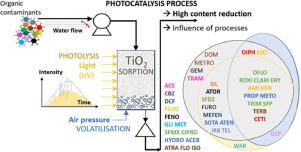Water Research ( IF 12.8 ) Pub Date : 2022-06-18 , DOI: 10.1016/j.watres.2022.118777 Reoyo-Prats Brice 1 , Sellier Anastasia 2 , Khaska Somar 2 , Le Gal Lassalle Corinne 2 , Weiss Karine 2 , Goetz Vincent 1 , Plantard Gaël 1

|
Wastewater is a major issue for the ecosystem because of its considerable quantities, the treatment methods adopted in the large majority of WWTPs, and its level of contamination by various types of pollutants, especially emerging ones. One of the solutions considered to reduce this pressure on water is the reuse of wastewater after treatment for watering green areas, road cleaning, industry, groundwater recharge but also for crop irrigation. This paper proposes to study the capabilities of a photoreactor for the removal of micropollutants contained in wastewater from wastewater treatment plants. The experiments are carried out under dynamic artificial irradiation conditions which can be controlled in order to apply irradiation representative of the sunshine conditions. The experiments aim at treating a real effluent from urban wastewater. On the basis of these data, the photo-oxidation mass capacities expressed per unit of irradiated surface and per day were evaluated. Our results show that the oxidation process acts in a selective and differentiated manner according to the categories of substances and within each category. Some molecules are not or only partially oxidized. Note that the photo-reactor fed continuously with wastewater from wastewater treatment plants containing about 80 substances, is subjected to a typical irradiation setpoint of a sunny day in April. This allows to define the instantaneous and daily capacities of the system with respect to the target molecules.
中文翻译:

通过动态条件下的光氧化连续降解现实世界处理过的废水中的微污染物
废水是生态系统的一个主要问题,因为废水量大,大多数污水处理厂采用的处理方法,以及各种污染物,特别是新兴污染物的污染程度。为减轻水的压力而考虑的解决方案之一是将处理后的废水再利用,用于浇灌绿地、道路清洁、工业、地下水补给以及作物灌溉。本文建议研究光反应器去除废水处理厂废水中微污染物的能力。实验是在可以控制的动态人工辐照条件下进行的,以便应用代表日照条件的辐照。实验旨在处理来自城市废水的真实流出物。在这些数据的基础上,评估了每单位照射表面和每天表示的光氧化质量容量。我们的结果表明,氧化过程根据物质的类别和每个类别以选择性和差异化的方式起作用。一些分子没有或仅部分氧化。请注意,光反应器从废水处理厂连续输送含有约 80 种物质的废水,在 4 月阳光明媚的日子的典型辐照设定点。这允许定义系统相对于目标分子的瞬时和每日容量。我们的结果表明,氧化过程根据物质的类别和每个类别以选择性和差异化的方式起作用。一些分子没有或仅部分氧化。请注意,光反应器从废水处理厂连续输送含有约 80 种物质的废水,在 4 月阳光明媚的日子的典型辐照设定点。这允许定义系统相对于目标分子的瞬时和每日容量。我们的结果表明,氧化过程根据物质的类别和每个类别以选择性和差异化的方式起作用。一些分子没有或仅部分氧化。请注意,光反应器从废水处理厂连续输送含有约 80 种物质的废水,在 4 月阳光明媚的日子的典型辐照设定点。这允许定义系统相对于目标分子的瞬时和每日容量。



























 京公网安备 11010802027423号
京公网安备 11010802027423号